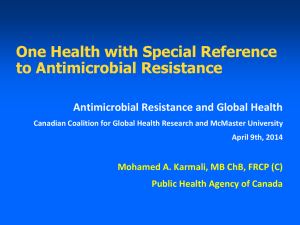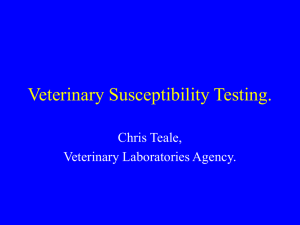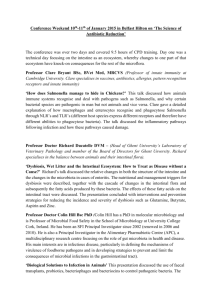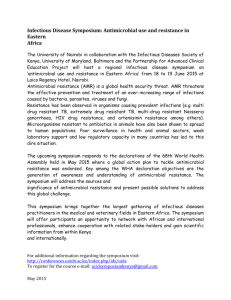DAFM surveillance on AMR - Department of Agriculture
advertisement
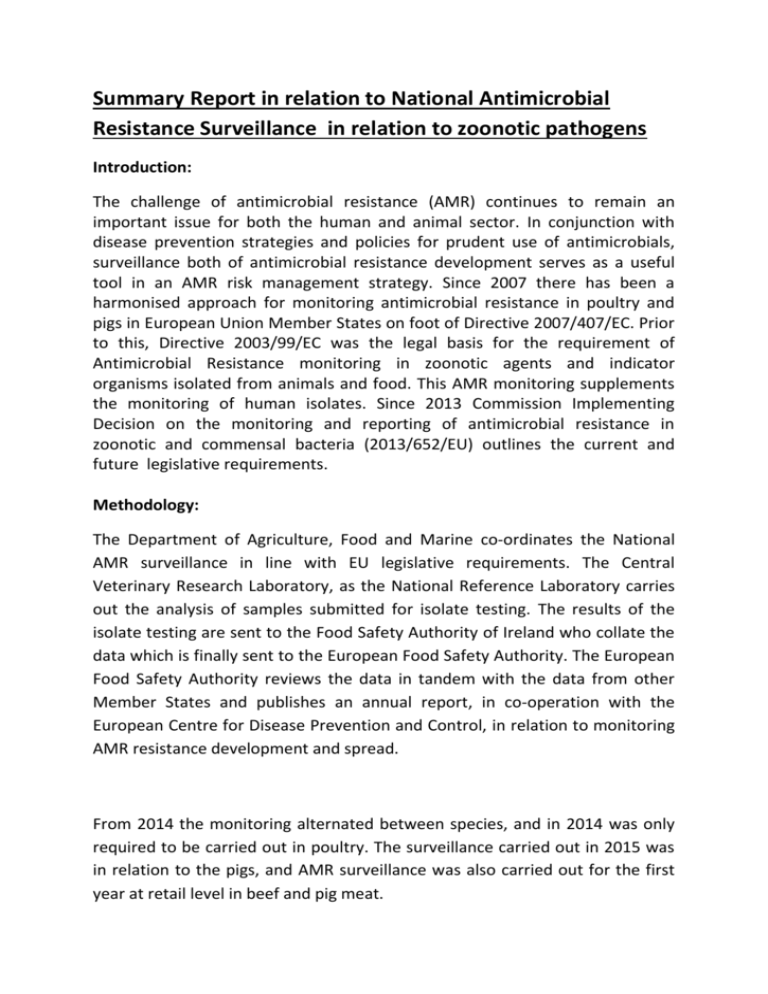
Summary Report in relation to National Antimicrobial Resistance Surveillance in relation to zoonotic pathogens Introduction: The challenge of antimicrobial resistance (AMR) continues to remain an important issue for both the human and animal sector. In conjunction with disease prevention strategies and policies for prudent use of antimicrobials, surveillance both of antimicrobial resistance development serves as a useful tool in an AMR risk management strategy. Since 2007 there has been a harmonised approach for monitoring antimicrobial resistance in poultry and pigs in European Union Member States on foot of Directive 2007/407/EC. Prior to this, Directive 2003/99/EC was the legal basis for the requirement of Antimicrobial Resistance monitoring in zoonotic agents and indicator organisms isolated from animals and food. This AMR monitoring supplements the monitoring of human isolates. Since 2013 Commission Implementing Decision on the monitoring and reporting of antimicrobial resistance in zoonotic and commensal bacteria (2013/652/EU) outlines the current and future legislative requirements. Methodology: The Department of Agriculture, Food and Marine co-ordinates the National AMR surveillance in line with EU legislative requirements. The Central Veterinary Research Laboratory, as the National Reference Laboratory carries out the analysis of samples submitted for isolate testing. The results of the isolate testing are sent to the Food Safety Authority of Ireland who collate the data which is finally sent to the European Food Safety Authority. The European Food Safety Authority reviews the data in tandem with the data from other Member States and publishes an annual report, in co-operation with the European Centre for Disease Prevention and Control, in relation to monitoring AMR resistance development and spread. From 2014 the monitoring alternated between species, and in 2014 was only required to be carried out in poultry. The surveillance carried out in 2015 was in relation to the pigs, and AMR surveillance was also carried out for the first year at retail level in beef and pig meat. Results and discussion: Surveillance in relation to levels of antibiotic resistance in the following specific zoonotic pathogenic bacteria, Salmonella spp., Campylobacter spp., and E. coli has been ongoing since 2010 in cattle, pigs and poultry. Table 1: CVRL data for the number of Isolates tested per year 2010-2014 Genus (slide preparation courtesy of Food Safety Authority of Ireland, 2015) Reporting Year Campylobacter 2010 2011 2012 2013 2014 127 146 78 Total: 351 Escherichia coli, nonpathogenic Salmonella Grand Total 168 246 493 358 199 45 373 639 358 199 291 168 1341 1860 Figure 1: CVRL data regarding proportion of Isolates by Genus (slide courtesy of Food Safety Authority of Ireland, 2015) Table 1 and Figure 1 show the number of Isolates tested over the last 5 years. This data shows 78% of the isolates tested for antimicrobial resistance are from the genus Salmonella Table 2: Number of Antimicrobials tested by CVRL per year 2010-2014 Antimicrobial Substance Group Aminoglycosides Amphenicols Carbapenems Cephalosporins Fluoroquinolones Glycylcyclines Macrolides Penicillins Polymyxins Quinolones Sulfonamides Tetracyclines Trimethoprim Cephalosporins + ß lactamase inhibitors Total: 2010 1035 648 2011 1771 1132 2012 1074 716 2013 398 199 522 387 986 639 716 358 199 199 126 261 146 493 358 199 387 261 387 261 639 493 639 493 358 358 358 358 199 199 199 199 4275 7431 4654 1990 2014 411 213 240 461 312 213 312 221 213 312 213 312 213 Total 4689 2908 240 2884 1895 213 584 1532 213 1895 1524 1895 1524 16 16 3662 22012 Table 2 above shows the number of results that have been supplied over the last five years to the European Food Safety Authority in relation to the different antibiotic families. In 2014 AMR surveillance for antibiotic resistance in relation to 3rd and 4th generation cephalosporins, and surveillance for Extended Spectrum Beta Lactamase producing bacteria was carried out for the first time. Figure 2: AMR Surveillance findings in cattle, pigs and poultry from 2010-2013 (Slide prepared courtesy of the Food Safety Authority of Ireland, 2015) AMR Results 2010-2014 100% 90% % of total Results 80% 82% 85% 87% 81% 81% 70% 60% 50% % Susceptible 40% % Resistant 30% 20% 18% 10% 15% 13% 19% 19% 0% 2010 2011 2012 Year 2013 2014 Figure 2 shows the percentage of bacterial isolates that have been shown to be resistant or susceptible to antibiotics. The results over the 5 years from 20102014 show resistance levels staying below 20% in the isolates tested. The 2014 results are in line with 2013, with 2012 showing the lowest percentage of resistance detection, however in that year only Salmonella isolates were tested and submitted. Figure 3: Overview of CVRL data on source of Salmonella isolates tested for resistance to Amninoglycosides, Cephalosporins and Fluoroquinolones (Slide prepared courtesy of the Food Safety Authority of Ireland, 2015) In relation to Salmonella species testing, the breakdown of the species tested can be seen in figure 3, with the majority of testing being carried out in the pig population. Certain classes of antibiotics have been classified by both the World Health Organisation and the world Organisation for Animal health as Critically Important Antibiotics (CIAs) for both human and animal health. Both Flouroquinolone, 3rd and 4th Generation Cephalosporin and Aminoglycoside families of antibiotics have been included in this category. Figure 4: Salmonella isolates tested for resistance to Fluoroquinolones in poultry (slide prepared courtesy of Food Safety Authority of Ireland, 2015) Figure 4 shows that AMR trends in Salmonella species in poultry samples collected show a low level of resistance with none being detected in 2014. Figure 5: CVRL data with regard to Salmonella isolates from poultry tested for resistance to Cephalosporins (slide prepared courtesy of Food Safety Authority of Ireland, 2015) Susceptible 0% Resistant Susceptible 1% Resistant Resistant Susceptible 1% Susceptible 1% 1% 100% 99% 99% 99% Resistant 99% Susceptible 120% 100% 80% 60% 40% 20% 0% Resistant % of total results Salmonella Isolates - Cephalosporins Only Cephalosporins Cephalosporins Cephalosporins Cephalosporins Cephalosporins 2010 2011 2012 2013 2014 Resistance of Salmonella bacteria sampled from poultry to 3rd and 4th generation Cephalosporins was very low at 1%, to non-existent in 2014. However, in relation to Aminoglycoside resistance levels, again with regard to poultry, levels detected were higher when compared to other CIAs apart from 2014 when no resistance was found to be present (figure 6). Figure 6: CVRL data with regard to Salmonella isolates from poultry tested for resistance to Amninoglycosides (slide prepared courtesy of Food Safety Authority of Ireland, 2015) 89% 0% Resistant Susceptible Resistant Susceptible Susceptible 19% 11% Susceptible 13% 12% 100% 81% Susceptible 87% Resistant 88% Resistant 120% 100% 80% 60% 40% 20% 0% Resistant % of total results Salmonella Isolates - Aminoglycosides Only Aminoglycosides Aminoglycosides Aminoglycosides Aminoglycosides Aminoglycosides 2010 2011 2012 2013 2014 In relation to Campylobacter isolates from poultry samples there were significant levels of resistance detected in relation to Flouroquinolones (figure 7), although a marked decrease in 2014 when compared to previous data. Figure 7: CVRL data with regard to Campylobacter isolates from poultry tested for resistance to Flouroquinolones and Aminoglycosides 98% 40% 27% Susceptible Resistant Susceptible Resistant Susceptible Resistant Resistant 3% 2% Susceptible 5% 73% 60% 55% Resistant 45% 97% Susceptible 95% Susceptible 120% 100% 80% 60% 40% 20% 0% Resistant % of total results Campylobacter Isolates AminoglycosidesFluoroquinolonesAminoglycosidesFluoroquinolonesAminoglycosidesFluoroquinolones 2010 2011 2014 Conclusions: Surveillance of Antimicrobial resistance in different species does not show a significant increase over the past five years with levels staying below 20%. The data collected in relation to the poultry sector highlights that in 2014, there was no resistance found in Salmonella isolates to certain classes of antibiotics classified as critically important for human and animal health, specifically flouroquinolones, 3rd and 4th generation cephalosporins and aminoglycosides. The data from 2010-2014 showed a continual annual decrease in levels of resistance to Flouroquinolones and aminoglycosides in Campylobacter isolates from poultry. The data shows a continued improvement in antimicrobial resistance trends in poultry, however continued monitoring, in conjunction with a focus on disease prevention, and prudent use of antibiotics where necessary, is essential in all animal production sectors to address the development and spread of AMR.
